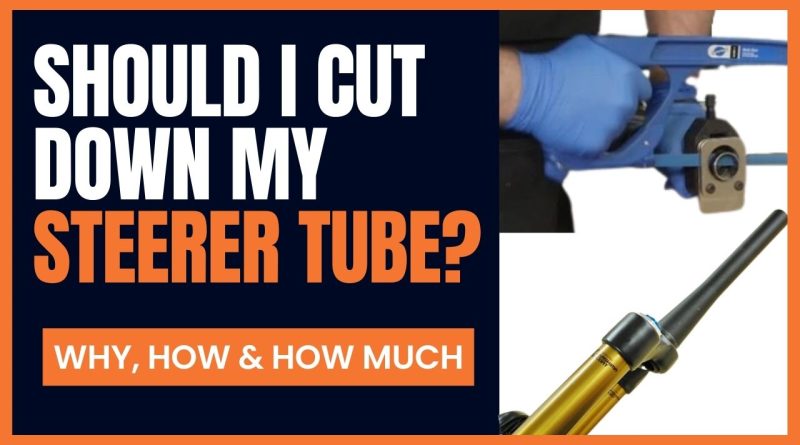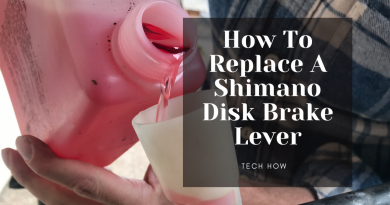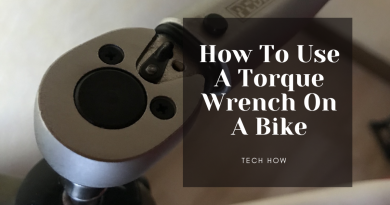Should I Cut Down My Steerer Tube? (Why, How & How Much)
People often ask ‘should I cut down my steerer tube?’. In this article, we look at the advantages and disadvantages of cutting down your steerer tube. We also guide you through how much to cut off, and how to do it. Plus we answer common questions to help you avoid any pitfalls when cutting down your steerer tube.
With that in mind, should you cut down your steerer tube?
- What is a Steerer Tube?
- What Are the Different Types and Sizes of Steerer Tubes?
- Why Do People Cut Down Their Steerer Tubes?
- Should I Cut Down My Steerer Tube?
- Is There Any Compromise?
- What Length to Cut Your Steerer Tube Down To? (How Much to Chop Off?)
- How to Cut Down an Alloy Steerer Tube?
- How to Cut Down a Carbon Steerer Tube?
- Can You Replace a Steerer Tube?
- What to Do if Your Steerer Tube Is Too Short? (Can You Extend a Steerer Tube)
- Conclusion
What is a Steerer Tube?
The steerer tube is a tube that’s attached to the top of every bicycle fork. It fits through the headset on the frame connecting the forks to the stem and handlebars. They are normally designed to be compatible with a headset which allows you to steer the bike – hence the bike ‘steerer tube’.

What Are the Different Types and Sizes of Steerer Tubes?
You want to ensure you have the correct diameter steerer tube for your bike’s frame and headset. Bear in mind many higher-end bikes have tapered steerer tubes (meaning larger at the bottom and smaller at the top)
Sizes
Steerer tube sizes come in a variety of diameters: 1 inch, 1 1/8 inch, 1.25 inch and 1.5-inch steerers. It’s uncommon but you may also encounter a 1-inch threadless steerer tube, however, a 1-inch threaded steerer is slightly more common.
Most modern bikes either have a 1 1/8 inch straight steerer tube, or a 1.5-inch to 1 1/8 inch tapered steerer tube.
Materials
Steerer tubes are commonly made from aluminium (7000 or 7075 series aluminium). However, some height-end bikes have carbon fibre steerer tubes.
Can You Trust Carbon Fibre Frames? (Explained)
Why Do People Cut Down Their Steerer Tubes?
Steerer tubes normally come longer than they need to be so the fork will be comparable with different length headtubes (different size frames) and allow the rider to select their preferred handlebar height. Once people have decided on their preferred handlebar height, it’s common to cut down their steerer tube so they don’t have a long, dangerous tube sticking out the front of their bike.
Should I Cut Down My Steerer Tube?
New forks – If you have a new full-length steerer tube you should almost certainly cut it down for safety reasons. Having a big metal tube sticking out from the front of your bike probably isn’t the best idea if you have an accident.
Old forks – You should only consider cutting down your steerer tube on older forks if you require more than 2 spacers on top of the stem to get your desired stem height.
Pros of Cutting Your Steering Tube
Stay safe – Most people would agree it’s probably safer not to have a big metal pole sticking out of the front of your bike.
Clean look – Many bike riders like to have their headset cap flush with the top of their stem, which creates a nice clean look.
Confidence/experience – many experienced riders will have spent years experimenting to find their ideal stem height.
Weight – The weight saving is relatively negligible. However, for the weight weenies looking to save every gram, it could be another thing to consider.
Cons of Cutting Down Your Steerer Tube
Moving forks to another bike – If you think you could fit the forks to another bike in the future, then you may want to leave some extra steerer tube length. This is because different frames have different length head tubes. So If your steerer is cut nice and flush with the stem on one bike it might not be long enough to fit another bike.
Ability to adjust – Many riders like the ability to adjust their stem height, which will affect how the bike handles. If you cut your steerer tube short then it will limit the amount you can adjust the stem height, Which can be annoying if you want to raise your stem in the future.
Resale value – If you plan on selling your forks so you can upgrade them in the future, you may want to leave some extra steerer tube length to it will fit other bikes. Simply the shorter you cut down your steerer tube, the fewer people will be able to buy your forks, meaning either selling them for less, or if they are too short you might not be able to sell them at all.
Is There Any Compromise?
Basically, you have to decide if you want to save a little weight and have a clean look or have adjustability plus better resale value. Personally, I like to sit between the two and have a couple of spacers that sit on top of the stem, which gives some adjustability and improves resale value.

What Length to Cut Your Steerer Tube Down To? (How Much to Chop Off?)
This question comes down to an element of personal preference. First, you need to decide what’s your preferred handlebar height. If you’re an experienced rider then you should have a good idea of your preferred height.
If you are unsure then I would recommend starting by adding 2-3 spacers (5mm spacers) under the stem and going for a short ride to see how it feels. Then add or remove spacers until you are happy with the stem height. Once you’re happy I’d recommend putting 2 spacers on top of the stem (to allow adjustment), then you want to cut the steerer tube 3-4mm below where the top spacer sits on the steerer tube.
How to Cut Down an Alloy Steerer Tube?
Step 1. Tools needed
- Marker pen
- Hacksaw and saw guide (or a pipe cutter)
- Metal file
You will also likely need a star-nut and a star-nut fitting tool once you have cut down your steerer tube.
Step 2. Determine Where to Cut
Deciding where to cut is probably the most important part to ensure you get right. If you are not 100% sure, I’d say its better to leave a little extra steerer tube so you can always cut it off later.
- If it’s a new steerer tube, fit the crown race and side the steerer snugly into the headset of the bike. Ensure you have all the parts of the headset installed (except the top cap).
- Now add 2-3 headset spacers and slide on the stem and handlebars. Experienced riders should be able to add and remove spacers until they are happy with the stem/handlebar height. If you’re unsure, add 3 x 5mm headset spacers under the stem.
- For most people, I’d recommend adding 2 x 5mm headset spacers on top of the stem. If you are really unsure and want to have room to change your mind then add 3 or even 4 x 5mm headset spacers – This should allow plenty of room to change your mind at a later date.
- Now mark with your pen around the top headset spacer, and measure 3mm under that line. This is where you need to cut.
Step 3. How to Cut the Steerer (Measure Twice, Cut Once)
- Check – Sounds obvious, but always measure twice and cut once! Ensure the headset is all tight and flush when measuring.
- Cutting with a hacksaw – It’s recommended to use a hacksaw guide, like the one from park tool, remember to line up the saw guide over the pen line. Using a fresh/sharp blade will make cutting easier and give a cleaner cut.
- Cutting with a pipe cutter – Over the years a pipe cutter has become my preferred tool for cutting down steerer tubes (also, handlebars and seat posts). Simply, line up the tool with the pen guideline, and keep twisting the pipe cutter until you have a nice clean cut.
Step 4. Clean Steerer Tube, Re-install
- File – If you have used a hacksaw or a pipe cutter it’s recommended to use a file to clean up the steerer tube to remove any sharp or rough edges.
- Finally, reinstall your headset with all the spacers. If you have measured and cut correctly it should all tighten up well, and sit flush.
Note: If you notice your headset is not tightening up, you may need to add another spacer.
How to Cut Down a Carbon Steerer Tube?
Cutting down a metal steerer tube is not too complicated, however, with a carbon steerer tube, there are some other things to consider.
Step 1. Tools Needed
- Marker pen
- Hacksaw with a carbon blade
- Saw guide
- Electric tap
- Water
- Sand paper
- Gloves and Mask
- Water
Step 2. Safety
- Safety – always wear a mask, and gloves when cutting carbon fibre. it’s easy to get carbon strands under your skin or breathe in carbon dust (both should be avoided!)
Step 3. Determine Where to Cut
Deciding where to cut is probably the most important part to ensure you get right. If you are not 100% sure, I’d say it’s better to leave a little extra steerer tube so you can always cut it off later.
- If it’s a new steerer tube, fit the crown race and side the steerer snugly into the headset of the bike. Ensure you have all the parts of the headset installed (except the top cap).
- Now add 2-3 headset spacers and slide on the stem and handlebars. Experienced riders should be able to add and remove spacers until they are happy with the stem/handlebar height. If you’re unsure, add 3 x 5mm headset spacers under the stem.
- For most people, I’d recommend adding 2 x 5mm headset spacers on top of the stem. If you are really unsure and want to have room to change your mind then add 3 or even 4 x 5mm headset spacers – This should allow plenty of room to change your mind at a later date.
- Now mark with your pen around the top headset spacer, and measure 3mm under that line. This is where you need to cut.
- Take your electric tape and wrap the outside edge of the tape around the steerer tube below the cutting line. Now do the same above the cutting line, slightly overlapping – the overlap is now the cutting guideline. The purpose of this is to help keep down carbon particles while cutting.
Step 4. How to Cut a Carbon Steerer Tube (Measure Twice, Cut Once)
- Check – Sounds obvious, but always measure twice and cut once! Ensure the headset is all tight and flush when measuring.
- Guide – line a saw guide over the overlapping tape guideline.
- How to cut – take your carbon hacksaw blade and slowly start to cut. Every 5-6 strokes pour a few drops of water over the cutting area. This will help both lubricate the cutting and reduce any airborne carbon particles. keep on cutting until you have cut completely through.
Step 5. Clean Steerer Tube, Re-install
- Sand – It’s recommended to use sandpaper to clean up the steerer tube to remove any sharp or rough edges. (keep wearing a mask and gloves for this step)
- Finally, reinstall your headset with all the spacers. If you have measured and cut correctly it should all tighten up well, and sit flush.
Note: If you notice your headset is not tightening up, you may need to add another spacer.
Can You Replace a Steerer Tube?
Officially you cannot replace steerer tubes as they are often bonded or tightly press fitted into the fork’s crown. Most fork manufacturers do not offer steerer tube replacements and would NOT advise you to replace the steerer tube in the crown.
Some fork manufacturers will sell replacement crowns and steerer tubes if required, and others sometimes offer warranty replacements for faulty products.

This is NOT recommended, but to answer the question fully, yes it is possible to replace a steerer tube in a crown. This normally involves pressing out the old tube and pressing in, or bonding the new tube back into the crown. However, unless you have the right tools and experience it’s not worth the risk, it’s much better to buy a crown and steerer combo.
What to Do if Your Steerer Tube Is Too Short? (Can You Extend a Steerer Tube)
If your steerer tube is too short you have a number of options, like steerer tube extenders, high-rise stems, and high-rise handlebars.
- Steerer Tube Extenders slot into your current steerer tube and give you more tube to play with.

- High Rise Stems can be a good option if you have enough steerer tube to fit a stem, as they can give you a higher handlebar height.

- Other options are high-rise handlebars, or the best but most expensive option is replacing your crown and steerer tube.
Conclusion
Everyone should cut down their steerer tube to some degree. If you want maximum adjustment and maximum resale value cut less off. Likewise, if you like a clean flush stem look, with a small amount of weight saving then cut your steerer tube down to your preferred height.
There is no right or wrong answer, different people like different things, what do you prefer? Personally, I’d say leave a little steerer tube to play with to allow some adjustment.
You may also like:




